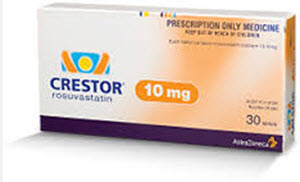 Type: HMG-CoA reductase inhibitor
Type: HMG-CoA reductase inhibitor
Active ingredient: Rosuvastatin calcium
Common use: Crestor is an HMG-CoA reductase inhibitor (statin). It is chiefly used to treat high LDL cholesterol (dyslipidemia), high total cholesterol (hypercholesterolemia), high triglycerides (hypertriglyceridemia), and to prevent cardiovascular events. Crestor is similar to most other synthetic statins (such as atorvastatin and pitavastatin), but unlike most other statins Crestor contains sulfur.
How to use: Unless otherwise ordered by your doctor, Crestor should be swallowed whole with a glass of water. Crestor can be taken with or without food.
Antacids containing aluminum and/or magnesium hydroxide should not be taken within two hours of taking Crestor.
If you miss a dose of Crestor, take it as soon as possible. If it is almost time to take your next dose, skip the missed dose permanently and stick to your regular dosing schedule. Do no take two doses at once or near each other in time.
How to store: Store Crestor at room temperature in a tightly-closed container, and keep away from heat, light and moisture.
Warnings:
- If you develop symptoms of an allergic reaction, seek immediate medical attention. Examples of symptoms of an allergic reaction are rash, itching, hives, difficulty swallowing, hoarseness, numbness or tingling in fingers or toes, difficulty breathing, swollen face, swollen throat, swollen tongue, swollen lips, swollen eye lids, swollen hands, swollen ankles, swollen feet or swollen lower legs.
- Like all other statins, Crestor can cause myoparthy and rhabdomyolysis. Stop taking Crestor and contact your doctor if you experience muscle pain, muscle weakness, fatigue, fever, chest pain, yellowing of the skin, yellowing of the eyes, dark urine, foamy urine, pain in the upper right part of your abdomen, nausea, easy bruising, easy bleeding, flue-like symptoms, sore throat or chills.
- Antacids containing aluminum and/or magnesium hydroxide should not be taken within two hours of taking Crestor.
- Always tell your doctor about previous and current health conditions, as well as any medication you use or may use while being treated with Crestor. There are many medical conditions and medical treatments that make the use of Crestor risky. Examples of such medical conditions are liver problems and elevation of serum transaminases.
Examples of medicines that may have negative interactions with Crestor:
Anticoagulants, such as warfarin, cimetidine and cyclosporine
Medications for high cholesterol, such as clofibrate, fenofibrate and gemfibrozil
Certain HIV medication or combinations of HIV medications
Eluxadoline taken with Crestor can increase the risk of Rhabdomyolysis
- Alcohol intake should be limited while being treated with Crestor, since alcohol increases the risk of liver damage.
- It is important to keep all doctors appointments and laboratory appoints while being treated with Crestor.
- Using Crestor while pregnant is not recommended. It can cause serious harm to the unborn.
- It is not known if Crestor is excreted in breastmilk. Using Crestor while breastfeeding is not recommended, since this medicine has the potential of disrupting the child’s lipid metabolism.
- Certain East Asian populations appear to process Crestor differently. To reduce the risk of myopathy, patients with an East Asian genetic profile should be started on the lowest dose level and then evaluated. In some cases, half the standard dose will have the same cholesterol-lowering effect as a full dose has in non-East Asian populations.
Examples of reported side effects:
- confusion
- constipation
- cough
- dizziness
- depression
- heartburn
- insomnia
- joint pain
- memory loss or forgetfulness
